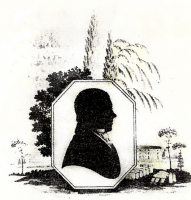










William Weston Young (1776–1847) Quaker Entrepreneur of Bristol and Glamorganshire; artist, botanist, wreck-raiser, surveyor, potter, and inventor of the firebrick.
Biography
William Weston Young, born 20 April 1776, Lewin's Mead, Bristol, England, into a devout Quaker family, the third son of Edward Young, a Bristolian merchant and Sarah (Sally) Young (née Weston). He was educated at Gildersome Quaker boarding school in Yorkshire, which among other things gave him a rudimentary knowledge of science which he was to apply in his invention of the silica firebrick.
After a flustered attempt to emigrate to America in 1794, involving his ship being captured by a fleet of French men-of-war, his ultimate escape from captivity and arduous journey home, Young settled back in Bristol, found employment and married fellow Quaker, Elizabeth Davis, in April 1795. In 1798, Young had acquired the financial backing (with notable help from his uncle Thomas Young, father of the physicist, physician and egyptologist Dr Thomas Young) to lease a farm and water mill from John Llewellyn of Ynysygerwn, at Aberdulais, in the Neath Valley, Glamorganshire. After a lucrative start to his new venture as a miller, corn-factor and farmer, a large purchase of corn, beans and grist coinciding with the Treaty of Amiens, which crashed the value of his goods, as well as some unfortunate dealings with men of false credit brought Young into trouble with his own creditors, and was made bankrupt in May 1802.
The Dinas Firebrick
Young's experience of firing ceramics, together with his familiarity with the region as a local surveyor and his amateur interests in geology enabled him to conceive of a heat-proof, blast-furnace brick, using silica found in large deposits at the head of the Neath Valley. The process of "vitrifying" the walls of a ceramic brick-built furnace had been patented by William Harry, of the Swansea Valley in 1817, but Young's solution was to build the whole furnace from a "silica firebrick," made with a 1% addition of lime, to bind the blue-grey "clay" of the Dinas rock. The idea being that the interior of the blast furnace would vitrify and be vastly more durable and ultimately economical, than a mere veneer of silica within a comparatively fragile ceramic shell. Young made early experiments with the recipe and fired his trial bricks at the Nantgarw Pottery kilns, while he and Pardoe finished the Billingsley porcelain for sale between 1820 and 1821 when he finalised his recipe.
In 1822, Young applied to the Marquis of Bute to lease the lands near Craig-y-Dinas, Pontneddfechan, in the upper Neath Valley for a period of twenty-one years. Young had the lease, and the patent (No. 5047) but had no funds left to set up the required brickworks. He sought financial backing from a number of sources, including his extended family once more and on 19 October 1822, the Dinas Fire Brick Co. was established in a partnership involving David Morgan, a Neath Ironmonger, John Player and Joseph Young (William Weston Young's older brother). (W.W. Young was a party but could not be a partner in the final enterprise, owing to his previous bankruptcy in 1802 at Aberdulais watermill.) A brickworks was built at Pontwalby, about a mile down river from Craig-y-Dinas.
The lucrative company, which sold bricks to industry across the world, transferred through many hands, but the Young family, held their shares throughout, finally passing via Joseph Young to his son William Weston Young Junior (1798–1866). (William Weston Young had no children). From "The Dinas Firebrick Co." to "John Player & Co." in 1825, to "Riddles, Young & Co." in 1829 and finally, becoming world famous as "Young & Allen" in 1852, the company brochure later mentions that it had supplied firebricks to Swansea's White Rock Copper Works for forty years.
The Final years
The Dinas Firebrick Works experienced some financial and technical troubles during 1829, and Young laid out further monies to support his nephew William Weston Young Jr.'s stake in the company, but the company traded at limited profits for some time, requiring Young to start painting commercially yet again, this time in watercolours of the Neath Valley, where he'd moved once more, to Fairyland House, near the Ivy Tower on the Mackworth Estate, Tonna, Neath, Glamorganshire.
In 1835, Young published an eighty-five-page, illustrated book Guide to the Scenery and Beauties of Glyn Neath, published by John Wright & Co. Bristol and sold by Longman, Rees, Orme, Browne & Co. London MDCCCXXXV. The naive but charming book comprises a prose guide to the Neath Valley and is illustrated with landscapes, scenery and decorative topographical and geological maps.
Young's wife; Elizabeth died following an awkward fall in March 1842, prompting Young to publish in 1843; The Christian Experience of Elizabeth Young, as a tribute to her, again published by Young's friend John Wright & Co. Bristol.
William Weston Young's profit share from the Dinas Firebrick Works was ultimately a very modest pension, and he died in relative poverty in Lower Mitton, Kidderminster on 5 March 1847.